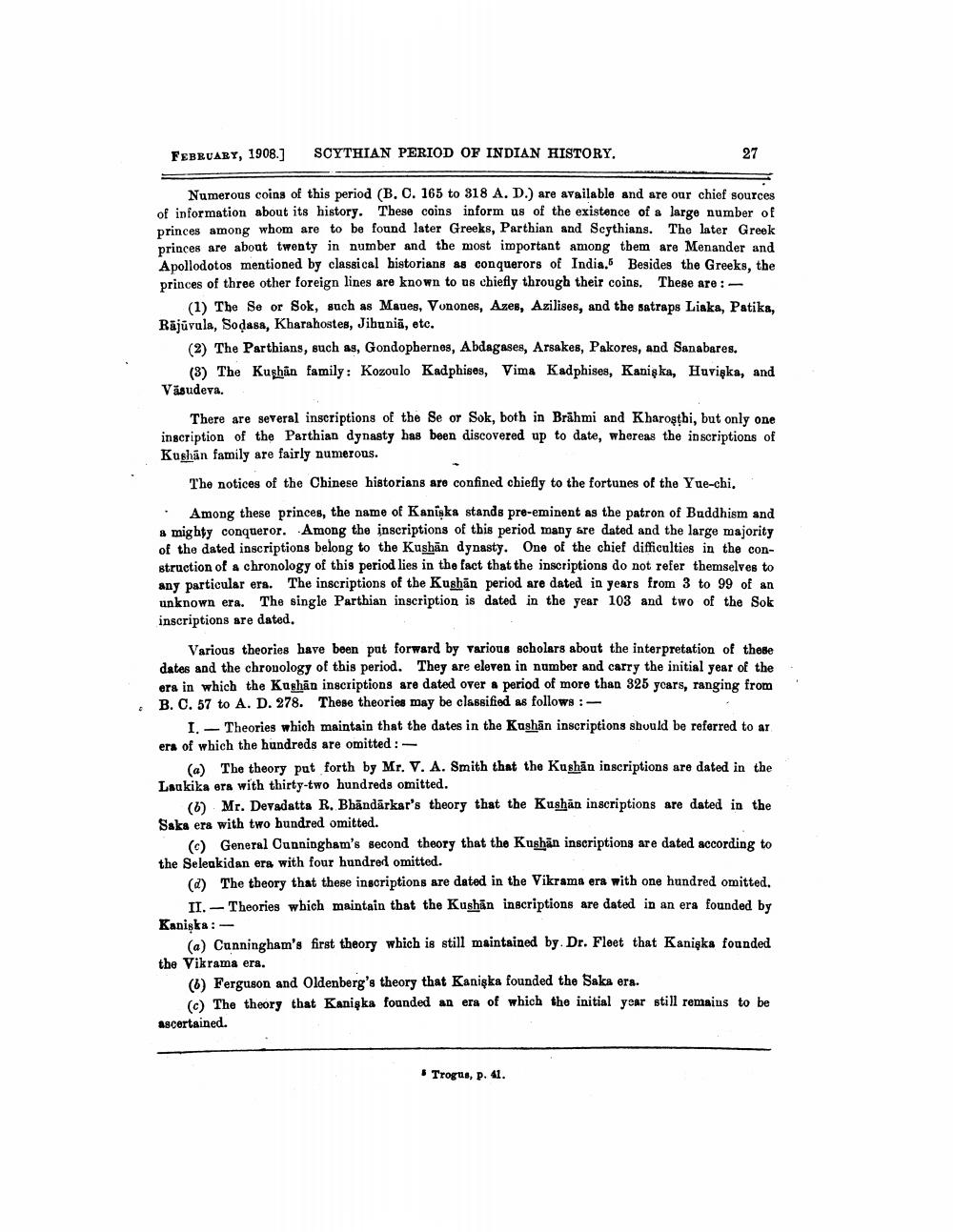________________
FEBRUARY, 1908.)
SCYTHIAN PERIOD OF INDIAN HISTORY.
27
Numerous coins of this period (B, C. 165 to 318 A. D.) are available and are our chief sources of information about its history. These coins inform us of the existence of a large number of princes among whom are to be found later Greeks, Parthian and Scythians. The later Greek princes are about twenty in number and the most important among them are Menander and Apollodotos mentioned by classical historians as conquerors of India. Besides the Greeks, the princes of three other foreign lines are known to us chiefly through their coins. These are:
(1) The Se or Sok, such as Maues, Vonones, Azes, Azilises, and the satraps Liaka, Patika, Rājūvula, Sodasa, Kharahostes, Jibuniã, etc.
(2) The Parthians, such as, Gondopbernes, Abdagases, Arsakes, Pakores, and Sanabares.
(3) The Kushan family: Kozoulo Kadphises, Vima Kadphises, Kaniş ka, Huviska, and Vasudeva.
There are several inscriptions of the Se or Sok, both in Brāhmi and Kharogthi, but only one inscription of the Parthian dynasty has been discovered up to date, whereas the inscriptions of Kushān family are fairly numerous.
The notices of the Chinese historians are confined chiefly to the fortunes of the Yue-chi.
. Among these princes, the name of Kaniska stands pre-eminent as the patron of Buddhism and & mighty conqueror. Among the inscriptions of this period many are dated and the large majority of the dated inscriptions belong to the Kushān dynasty. One of the chief difficulties in the construction of a chronology of this period lies in the fact that the inscriptions do not refer themselves to any particular ers. The inscriptions of the Kushān period are dated in years from 3 to 99 of an unknown era. The single Parthian inscription is dated in the year 103 and two of the Sok inscriptions are dated.
Various theories have been put forward by various scholars about the interpretation of these dates and the chronology of this period. They are eleven in number and carry the initial year of the era in which the Kushān inscriptions are dated over a period of more than 325 years, ranging from B. C. 57 to A. D. 278. These theories may be classified as follows:
I. - Theories which maintain that the dates in the Kushān inscriptions should be referred to ar era of which the hundreds are omitted :
(a) The theory put forth by Mr. V. A. Smith that the Kushān inscriptions are dated in the Laukika era with thirty-two hundreds omitted.
(6) Mr. Devadatta R. Bbāndārkar's theory that the Kushan inscriptions are dated in the Saka era with two hundred omitted.
(c) General Cunningham's second theory that the Kushān inscriptions are dated according to the Seleukidan era with four hundre omitted.
(d) The theory that these inscriptions are dated in the Vikrama era with one hundred omitted.
II. - Theories which maintain that the Kushan inscriptions are dated in an era founded by Kanişka :
(a) Cunningham's first theory which is still maintained by. Dr. Fleet that Kaniska founded the Vikrama era.
(6) Ferguson and Oldenberg's theory that Kaniska founded the Saka era.
(c) The theory that Kanişka founded an era of which the initial year still remains to be ascertained.
• Trogus, p. 41.




